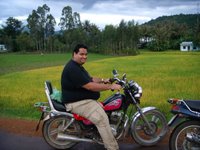 Day 1 Continues - Dalat to Lak Lake – 160 km
Day 1 Continues - Dalat to Lak Lake – 160 kmNote: Some of the pictures in this blog are actually videos. They should have a play button at the bottom of the picture. Try it out.
First the Worm Turns into a Cocoon, Then You Kill It
We next stopped in a silk factory. Mulberry trees are abundant in the area and the farmers grow silk worms on them and bring them in for processing once they turn into cocoons. For those who've not seen silk worms in the past, the cycle is roughly like this. Start with an egg, the size of a poppy seed (you'll never look at a bun the same again, will you?). The egg hatches and a small worm starts eating its way through mulberry tree leaves. As the worm grows, it reaches 1.5-2 inches (5 cm) in length. Once done growing, the worm weaves a cocoons around itself and goes into a stage of metamorphosis. When I was young, I had a few wilk worms at home in a cardboard box on the refrigerator. Since we did not process the silk, we got to see what happens next. The cocoon hatches when the butterfly inside eats its way through the cocoon's end, destroying the thread in the process. It's a white, flightless butterfly that lays eggs and dies and the cycle begins again.
At the factory, they don't wait for the cocoons to hatch. Cocoons are brought from all over the area and collected in these big baskets.

Then they are put into boiling water and "cooked" until the butterworm inside dies. The cocoons then float in the water while one of these factory workers tries to find the thread and feed it into the machine to unravel and put on a spool.

The ones that can't be automatically unraveled are processed manually to produce stronger but less fine silk. What's left, dead butterworms, is collected in these baskets.
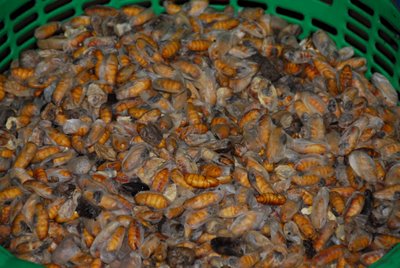
Since nothing goes to waste, maybe they feed it to the drunk pigs?
The thread is then collected in bigger spools. Some of it is sold as thread and some woven into fabric in a loom inside the factory.

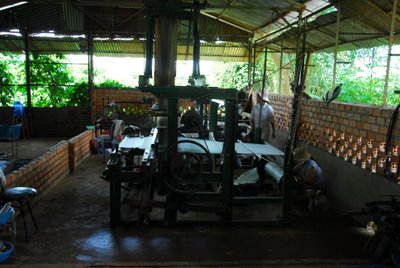
Driving Lesson #1 - The Horn The Horn, it Sounds So Forlorn
There are a number of switches you've got to make in your mind before successfully surviving driving in Vietnam. The first one is the use of the horn. In most western countries, the horn is used for 1) notifying of extreme danger, making you react quickly or 2) marking the end of a new-york second, the light has changed to green and why haven't you already started moving?
Its use in Vietnam (and as far as I recall in India too) is very different. First of all, it's not used as an emergency tool. The horn is used to notify someone of your presence. If you're driving behind them, you're responsible to move and accommodate them whatever they do. If you decide to pass them, you're likely to sound the horn to let them know you're coming. This is more common in the cities since there's less traffic to worry about when passing someone in the country side. A similar use is for cars and trucks to notify everyone that they're coming through and everyone had better MOVE or else bad things will happen. Again - this is not a sign of "emergency". More like "danger, danger Will Robinson" you'd better do something to accommodate it.
Lak Lake
On the first night, we stayed in a town on the shores of Lak Lake. The lake itself is very serene, still water with islands, fish traps and fisherman paddling around in dug out canoes.

Once we checked into the hotel, we drove on to the Jun village, a minority village where the M'Nong people live. M'Nong houses are long houses built on stilts. The extended family and all possesions live inside. Animals and livestock live under the house. The original houses were made of wood, though you could see a television set through the open doorway. The M'Nong grow rice, like most other people near large bodies of water. They also fish the lake extensively.
Cock Fighting
Another part of village life is animals in the street. On our way to the Jun village we came upon these two roosters fighting it out. In case you have never seen it, here's a short clip:
DAY 2- Lak Lake to Buon Ma Thuot – 105 km
Jimmy my Ride
We returned to the village the next morning. We had breakfast at the same “restaurant” as we had dinner. I asked for Pho, the vietnamese noodle soup that is part of the breakfat ritual. Apparently I surprised the propietor, who was expecting me to ask for an omelet. They only had instant-noodle. I was very disappointed. Instant noodles with powdered taste as part of ethnic food in Vietnam?
Then Jimmy gave me a ride. Allow me to introduce Jimmy. Jimmy is not his real name but I couldn’t pronounce, much less spell, his real name so Jimmy it’ll have to be.
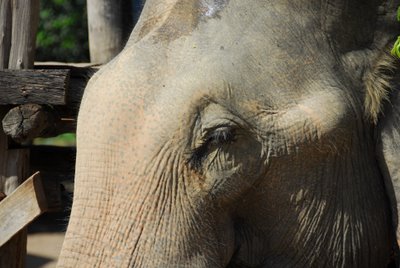
The M’Nong are famous for catching and rearing elephants. Jimmy was busy with breakfast too when we arrived, eating corn husks. Once he finished, I used the platform to climb up onto the box on Jimmy’s back. We started with a slow amble around the village. Jimmy’s driver was sitting on his neck, between the head and the body. He was driving Jimmy by pushing on his big ears with his feet. Anyone who’s ever held a child on their shoulders will probably know how that works :)

An elephant is not a smooth ride. With every step I was shifted a few inches left or right with my whole world tilting this way or that depending which foot Jimmy had in the air at the time. But apparently Jimmy is good for much more than walking on land. As we approached the water’s edge, Jimmy’s driver did not slow down. He kept us moving onwards. Jimmy approached the water, and step by slow step while checking the firmness of the ground with his snout, walked right in. He was up to his stomach in water, but we were safe and dry on his back, walking in the lake.
As we circumnavigated the village, we saw the local lake traffic go by, mostly fishermen in dugout canoes.

The ride was more than 30 mintes long and my legs were getting cramped from the sitting position. We eventually climbed back up onto land, and walked back to the village from its other side. From time to time Jimmy would stop walking and start turning aside and the driver would have to intervene. It took me a while to figure out he was smelling food – there was a fire burning dried-out corn husks on the side of the road – and Jimmy simply wanted a taste.
That Classic Vietnam Picture
We then jumped on our motorcycles and left the area, on to our second day of travel. Leaving Lak Lake, we saw a lot fo rice fields. I had an opportunity to take one of those classic photos you see on postcards and in books.
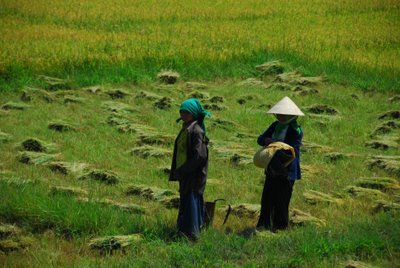
Our trip that day was relatively short, only 45km. On the second day of travel, my ass was really letting me know it feels the pain. In Buon Ma Thuot, we checked into a hotel, then went to have lunch. The food, called “Fried Pork” is really a roll-your-own-egroll. Rice paper (that really looks like paper – thin and brittle) is used for the outside. We added everything travelers should be worried about eating in foreign countries where the water is not to be trusted – lettuce leaves, green onion, etc, then some fried pork and fried rice paper. Once you roll the eggrol, you dip it into a special bowl of dipping sauce. As Phu (my guide) explained, all restaurants have pork and lettuce and rice paper. It’s the sauce that makes the place.
The thing I didn’t touch was a piece of raw pork meat that wrapped in a leave and left there for customers. Somehow, I don’t think the weather is all that suitable for natural preservation. It’s not like there’s snow on the window seals. My stomach is not that brave.
Driving Lesson #2 – Look left? Look right? Look?
We then proceeded to take a round trip to the Smoky Falls, picture below. Nothing special to tell about the trip except it was another 70km though the road was ok.
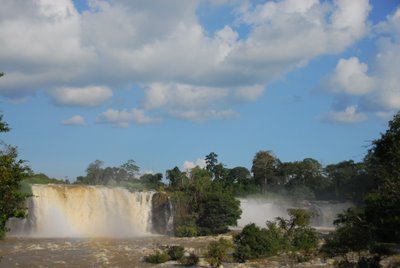
I used the time to observe some more of the unwritten driving laws of Vietnam. So you’re a motorcycle entering the endless stream of motorcycles driving down the stream of life that’s Vietnamese traffic. How do you do so?
1. If you’re approaching from another road, no problem. Simply start turning as you approach the new road. By the time you’ll reach it you’ll be almost parallel with traffic and people will swerve to give you some space. No need to check if the road is busy – after all, it always is.
2. You’re coming down from a sidewalk and there’s no space for you to align your motorcycle with the traffic? No problem! Just exit directly into the street perpendicular to traffic. You then have a second or so to realign yourself. Looking left and right? What for? There’s ALWAYS someone there so what’s the point? If you’ve been here long enough you know that a) cars travel in the middle of the road and honk when they arrive so you won’t hit one of those and b) motorcycles will swerve to give you space.
It was absolutely amazing to see how the Vietnamese pack their kids on the bike, then enter the road without checking for traffic first. I also almost hit one of these guys on the next-to-last day of the trip. This was an empty stretch of road so I was driving faster than usual when he just walked his motorcycle onto the road and blocked half the lane. I breaked in time, but was actually supposed to go around him had I been following the rules of the road.
Plop Goes the Weasel
Buon Ma Thuot is the center of coffee production in the Vietnam. Coffee is grown all over the mountains and brought to BMT for selling. The first stages of processing actually happens at the villages, in individual homes.
There are multiple coffee plantations like this coffee mountain.
Once the coffee is ready (when the beans are red), they are picked and dried up on mats outside the homes. The beans are then sifted for quality. There are three types of coffee beans grown in Vietnam and mixing them up is the art of creating good coffee.
The Vietnamese drink their coffee very strong, by taking ground beans and putting them onto a drip basket on top of the cup. Hot water is added and slowly drips through the coffee into the cup. Vietnam also export a lot of the coffee and is the 4th largest coffee exporter in the world.
What’s that weasel got to do with it you ask? Well, now we come to the most bizarre form of coffee making I’ve ever heard of. The priciest coffee (we’re talking 4x the cost of regular high quality coffee) is called weasel coffee. The process of making it is very similar to regular coffee, with one main difference. Instead of the beans being collected by people, weasels (yes, real weasels) are set loose among the beans to eat to their heart’s content. The beans travel through the weasel’s intenstines with the soft outer shell fruit being digested while the hard beans at the core are infused with a stronger, better aroma. Nature then takes it course and the weasel goes plop, at which point the villagers collect the beans and proceed with regular processing.
I shudder to think how this process was invented or why someone experimented with it. In any case, the coffee is highly prized and sold only in specialized stores. I couldn’t find a restaurant that serves it as a drink so I can’t tell you what the taste is like, but I did manage to buy some ground coffee. We’ll see how brave you are when I get back.
 And with plop goes the weasel I’ll conclude day 2 of, The Motorcycle Blogs.
And with plop goes the weasel I’ll conclude day 2 of, The Motorcycle Blogs.Technorati Tags: Vietnam, Silk, Silk Worms, Coffee, Weasel Coffee, Motorcycle, Elephants, Eran Davidov

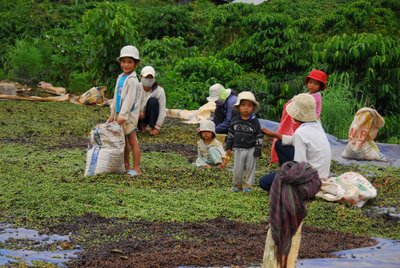
No comments:
Post a Comment